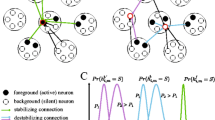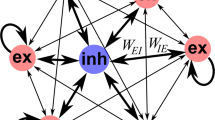Abstract
Associative memory has been a prominent candidate for the computation performed by the massively recurrent neocortical networks. Attractor networks implementing associative memory have offered mechanistic explanation for many cognitive phenomena. However, attractor memory models are typically trained using orthogonal or random patterns to avoid interference between memories, which makes them unfeasible for naturally occurring complex correlated stimuli like images. We approach this problem by combining a recurrent attractor network with a feedforward network that learns distributed representations using an unsupervised Hebbian-Bayesian learning rule. The resulting network model incorporates many known biological properties: unsupervised learning, Hebbian plasticity, sparse distributed activations, sparse connectivity, columnar and laminar cortical architecture, etc. We evaluate the synergistic effects of the feedforward and recurrent network components in complex pattern recognition tasks on the MNIST handwritten digits dataset. We demonstrate that the recurrent attractor component implements associative memory when trained on the feedforward-driven internal (hidden) representations. The associative memory is also shown to perform prototype extraction from the training data and make the representations robust to severely distorted input. We argue that several aspects of the proposed integration of feedforward and recurrent computations are particularly attractive from a machine learning perspective.
Funding for the work is received from the Swedish e-Science Research Centre (SeRC), European Commission H2020 program. The authors gratefully acknowledge the HPC RIVR consortium (www.hpc-rivr.si) and EuroHPC JU (eurohpcju.europa.eu) for funding this research by providing computing resources of the HPC system Vega at the Institute of Information Science (www.izum.si).
Access this chapter
Tax calculation will be finalised at checkout
Purchases are for personal use only
Similar content being viewed by others
References
Douglas, R.J., Martin, K.A.C.: Recurrent neuronal circuits in the neocortex. Curr. Biol. 17, R496–R500 (2007). https://doi.org/10.1016/J.CUB.2007.04.024
van Bergen, R.S., Kriegeskorte, N.: Going in circles is the way forward: the role of recurrence in visual inference. Curr. Opin. Neurobiol. 65, 176–193 (2020). https://doi.org/10.1016/J.CONB.2020.11.009
Stepanyants, A., Martinez, L.M., Ferecskó, A.S., Kisvárday, Z.F.: The fractions of short- and long-range connections in the visual cortex. Proc. Natl. Acad. Sci. U. S. A. 106, 3555–3560 (2009). https://doi.org/10.1073/pnas.0810390106
Hopfield, J.J.: Neural networks and physical systems with emergent collective computational abilities (associative memory/parallel processing/categorization/content-addressable memory/fail-soft devices). Proc. Natl. Acad. Sci. U. S. A. 79, 2554–2558 (1982)
Lansner, A.: Associative memory models: from the cell-assembly theory to biophysically detailed cortex simulations. Trends Neurosci. 32, 178–186 (2009). https://doi.org/10.1016/j.tins.2008.12.002
Hebb, D.O.: The Organization of Behavior. Psychology Press (1949). https://doi.org/10.4324/9781410612403
Lundqvist, M., Herman, P., Lansner, A.: Theta and gamma power increases and alpha/beta power decreases with memory load in an attractor network model. J. Cogn. Neurosci. 23, 3008–3020 (2011). https://doi.org/10.1162/jocn_a_00029
Silverstein, D.N., Lansner, A.: Is attentional blink a byproduct of neocortical attractors? Front. Comput. Neurosci. 5, 13 (2011). https://doi.org/10.3389/FNCOM.2011.00013/BIBTEX
Fiebig, F., Lansner, A.: A spiking working memory model based on Hebbian short-term potentiation. J. Neurosci. 37, 83–96 (2017). https://doi.org/10.1523/JNEUROSCI.1989-16.2016
MacGregor, R.J., Gerstein, G.L.: Cross-talk theory of memory capacity in neural networks. Biol. Cybern. 65, 351–355 (1991). https://doi.org/10.1007/BF00216968
LeCun, Y., Bengio, Y., Hinton, G.: Deep learning. Nature 521(7553), 436–444 (2015). https://doi.org/10.1038/nature14539
Mattar, M.G., Daw, N.D.: Prioritized memory access explains planning and hippocampal replay. Nat. Neurosci. 21, 1609–1617 (2018). https://doi.org/10.1038/S41593-018-0232-Z
Krotov, D., Hopfield, J.J.: Unsupervised learning by competing hidden units. Proc. Natl. Acad. Sci. U. S. A. 116, 7723–7731 (2019). https://doi.org/10.1073/pnas.1820458116
Bartunov, S., Santoro, A., Hinton, G.E., Richards, B.A., Marris, L., Lillicrap, T.P.: Assessing the scalability of biologically-motivated deep learning algorithms and architectures. In: Advances in Neural Information Processing Systems, pp. 9368–9378 (2018)
Illing, B., Gerstner, W., Brea, J.: Biologically plausible deep learning—but how far can we go with shallow networks? Neural Netw. 118, 90–101 (2019). https://doi.org/10.1016/j.neunet.2019.06.001
Ravichandran, N.B., Lansner, A., Herman, P.: Learning representations in Bayesian confidence propagation neural networks. In: Proceedings of the International Joint Conference on Neural Networks. (2020). https://doi.org/10.1109/IJCNN48605.2020.9207061
Ravichandran, N.B., Lansner, A., Herman, P.: Brain-like approaches to unsupervised learning of hidden representations - a comparative study. In: Farkaš, I., Masulli, P., Otte, S., Wermter, S. (eds.) ICANN 2021. LNCS, vol. 12895, pp. 162–173. Springer, Cham (2021). https://doi.org/10.1007/978-3-030-86383-8_13
Pulvermüller, F., Tomasello, R., Henningsen-Schomers, M.R., Wennekers, T.: Biological constraints on neural network models of cognitive function. Nat. Rev. Neurosci. 228(22), 488–502 (2021). https://doi.org/10.1038/s41583-021-00473-5
Mountcastle, V.B.: The columnar organization of the neocortex (1997). https://academic.oup.com/brain/article/120/4/701/372118. https://doi.org/10.1093/brain/120.4.701
Douglas, R.J., Martin, K.A.C.: Neuronal circuits of the neocortex (2004). www.annualreviews.org. https://doi.org/10.1146/annurev.neuro.27.070203.144152
Buxhoeveden, D.P., Casanova, M.F.: The minicolumn hypothesis in neuroscience. Brain 125, 935–951 (2002). https://doi.org/10.1093/BRAIN/AWF110
Carandini, M., Heeger, D.J.: Normalization as a canonical neural computation. Nat. Rev. Neurosci. 131(13), 51–62 (2011). https://doi.org/10.1038/nrn3136
Fransen, E., Lansner, A.: A model of cortical associative memory based on a horizontal network of connected columns. Netw. Comput. Neural Syst. 9, 235–264 (1998). https://doi.org/10.1088/0954-898X_9_2_006
Lansner, A., Ekeberg, Ö.: A one-layer feedback artificial neural network with a Bayesian learning rule. Int. J. Neural Syst. 01, 77–87 (1989). https://doi.org/10.1142/S0129065789000499
Sandberg, A., Lansner, A., Petersson, K.M., Ekeberg, Ö.: A Bayesian attractor network with incremental learning. Netw. Comput. Neural Syst. 13, 179–194 (2002). https://doi.org/10.1080/net.13.2.179.194
Lansner, A., Holst, A.: A higher order Bayesian neural network with spiking units (1996). https://doi.org/10.1142/S0129065796000816
Tully, P.J., Hennig, M.H., Lansner, A.: Synaptic and nonsynaptic plasticity approximating probabilistic inference. Front. Synaptic Neurosci. 6, 8 (2014). https://doi.org/10.3389/FNSYN.2014.00008/ABSTRACT
Johansson, C., Sandberg, A., Lansner, A.: A capacity study of a Bayesian neural network with hypercolumns. Rep. Stud. Artif. Neural Syst. (2001)
George, D., et al.: A generative vision model that trains with high data efficiency and breaks text-based CAPTCHAs. Science (80), 358 (2017). https://doi.org/10.1126/SCIENCE.AAG2612
Yamins, D.L.K., DiCarlo, J.J.: Using goal-driven deep learning models to understand sensory cortex. Nat. Neurosci. 193(19), 356–365 (2016). https://doi.org/10.1038/nn.4244
Felleman, D.J., Van Essen, D.C.: Distributed hierarchical processing in the primate cerebral cortex. Cereb. Cortex. 1, 1–47 (1991). https://doi.org/10.1093/cercor/1.1.1
Tang, H., et al.: Recurrent computations for visual pattern completion. Proc. Natl. Acad. Sci. U. S. A. 115, 8835–8840 (2018). https://doi.org/10.1073/PNAS.1719397115/SUPPL_FILE/PNAS.1719397115.SAPP.PDF
Roelfsema, P.R.: Cortical algorithms for perceptual grou** (2006). https://doi.org/10.1146/annurev.neuro.29.051605.112939
Wyatte, D., Curran, T., O’Reilly, R.: The limits of feedforward vision: recurrent processing promotes robust object recognition when objects are degraded. J. Cogn. Neurosci. 24, 2248–2261 (2012). https://doi.org/10.1162/jocn_a_00282
Fyall, A.M., El-Shamayleh, Y., Choi, H., Shea-Brown, E., Pasupathy, A.: Dynamic representation of partially occluded objects in primate prefrontal and visual cortex. Elife 6, (2017). https://doi.org/10.7554/eLife.25784
Li, W., Piëch, V., Gilbert, C.D.: Learning to link visual contours. Neuron 57, 442–451 (2008). https://doi.org/10.1016/J.NEURON.2007.12.011
Li, W., Gilbert, C.D.: Global contour saliency and local colinear interactions. J. Neurophysiol. 88, 2846–2856 (2002). https://doi.org/10.1152/JN.00289.2002
Lamme, V.A.F., Roelfsema, P.R.: The distinct modes of vision offered by feedforward and recurrent processing. Trends Neurosci. 23, 571–579 (2000). https://doi.org/10.1016/S0166-2236(00)01657-X
Grossberg, S.: Competitive learning: from interactive activation to adaptive resonance. Cogn. Sci. 11, 23–63 (1987). https://doi.org/10.1016/S0364-0213(87)80025-3
Rumelhart, D.E., Zipser, D.: Feature discovery by competitive learning. Cogn. Sci. 9, 75–112 (1985). https://doi.org/10.1016/S0364-0213(85)80010-0
Földiák, P.: Forming sparse representations by local anti-Hebbian learning. Biol. Cybern. 64, 165–170 (1990). https://doi.org/10.1007/BF02331346
Szegedy, C., et al.: Intriguing properties of neural networks. In: International Conference on Learning Representations, ICLR (2014)
Lake, B.M., Ullman, T.D., Tenenbaum, J.B., Gershman, S.J.: Building machines that learn and think like people. Behav. Brain Sci. 40 (2017). https://doi.org/10.1017/S0140525X16001837
Kietzmann, T.C., Spoerer, C.J., Sörensen, L.K.A., Cichy, R.M., Hauk, O., Kriegeskorte, N.: Recurrence is required to capture the representational dynamics of the human visual system. 116 (2019). https://doi.org/10.1073/pnas.1905544116
Rao, R.P.N., Ballard, D.H.: Predictive coding in the visual cortex: a functional interpretation of some extra-classical receptive-field effects. Nat. Neurosci. 21(2), 79–87 (1999). https://doi.org/10.1038/4580
Bastos, A.M., Usrey, W.M., Adams, R.A., Mangun, G.R., Fries, P., Friston, K.J.: Canonical microcircuits for predictive coding. Neuron 76, 695–711 (2012). https://doi.org/10.1016/J.NEURON.2012.10.038
Tully, P.J., Lindén, H., Hennig, M.H., Lansner, A.: Spike-based Bayesian-Hebbian learning of temporal sequences. PLOS Comput. Biol. 12, e1004954 (2016). https://doi.org/10.1371/JOURNAL.PCBI.1004954
Martinez, R.H., Lansner, A., Herman, P.: Probabilistic associative learning suffices for learning the temporal structure of multiple sequences. PLoS One 14, e0220161 (2019). https://doi.org/10.1371/JOURNAL.PONE.0220161
Author information
Authors and Affiliations
Corresponding author
Editor information
Editors and Affiliations
Rights and permissions
Copyright information
© 2023 The Author(s), under exclusive license to Springer Nature Switzerland AG
About this paper
Cite this paper
Ravichandran, N.B., Lansner, A., Herman, P. (2023). Brain-like Combination of Feedforward and Recurrent Network Components Achieves Prototype Extraction and Robust Pattern Recognition. In: Nicosia, G., et al. Machine Learning, Optimization, and Data Science. LOD 2022. Lecture Notes in Computer Science, vol 13811. Springer, Cham. https://doi.org/10.1007/978-3-031-25891-6_37
Download citation
DOI: https://doi.org/10.1007/978-3-031-25891-6_37
Published:
Publisher Name: Springer, Cham
Print ISBN: 978-3-031-25890-9
Online ISBN: 978-3-031-25891-6
eBook Packages: Computer ScienceComputer Science (R0)




